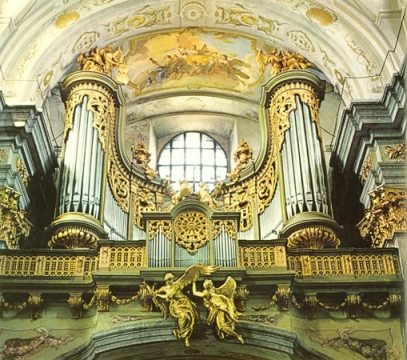

Sonntagberg
Franz Xaver Christoph 1774-1776
State of preservation: largely original.
The "sounding amphitheatre" by Franz Xaver Christoph resembles westphalian or northern German organs but in place of their acoustic centres, their monumental main organs, in Sonntagsberg there is - nothing, except the western window. The semicircle, elsewhere functioning as visual bridges between pedal and main organ here contains the pedal including main organ. This elegant façade is contrasting to the comparatively old fashioned parapet positive, its flat pipe fields and the "sun" in its centre reminding of style elements of the 16th and 17th centuries.
The sound design of the instrument contains some modern elements of the late 18th century, like the more expressive „Waltflöte“ im place of the common stopped diapason, as well as traditional Austrian features like the double Mixtur in HW („Mixtur solo“ to single stops, „Mixtur major“ to ripieno) and the linking of all high harmonics within one stop in pedal and positive. The term „FistlQuint“ for the rank of fifths in the positive shows a beginning dynamic graduation but also Christoph's sense of humour.
Specification
II+P; manuals C – d3, pedal C – a0
(C – B, rep. from c0)
HW:
Principal 8’ (2f. from c1)
Waltflaut 8’
Salicional 8’
Viola di Gamba 8’
Fleten 4’
Octav 4’
Mixtur Solo 4’ 2-4f.
Quint 3’
Superoctav 2’ (2f. from c1)
Mixtur major 2’ 5f.
Sequealta (1 3/5’+) 1 1/3’
Pos:
Copel Major 8’
Principal 4’
Fugara 4’
Spitzflöten 4’
FistlQuint 2 2/3’
Octav 2’
Mixtur 1 1/3’ 3-5f.
P:
Großprincipal 16’
Subbaß 16’
Principal Baß 8’
Octavbaß 8’
Violoncello 8’
Quintbaß 5 1/3’
Cornet 4’ 4f.
© Greifenberger Institut für Musikinstrumentenkunde | info@greifenberger-institut.de




